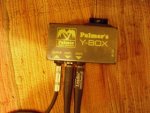I would like to record two guitar signals at the same time, one from a mic'd amp and one DI signal for reamping/virtual amps. Unfortunately I don't have a signal splitter or a mixer, and I heard that using a simply y-splitter plug coud cause tone loss, so I'm looking for another solution.
I'm thinking about plugging the guitar into the first input on my audio interface (Focusrite Scarlett 2i2), so I can record this signal in the DAW and also send it ( without any processing and at a low level) to one of the outputs, wich connects to the main input of a guitar amp (Marshall AVT100).
I guess the phase problems could be fixed by slightly delaying the DI signal, but what about impedance? The output impedace of my interface is <10 Ohms and the input impedance of the amp is 10M Ohms. Is this a problem? Or would it be better to use the FX Return of the amp? ( I don't know it's impedance, but at least it works with line level signals)
Have anyone tried something like this before? what do you think, could it work? If you have any other idea / solution please let me know!
Thanks!
I'm thinking about plugging the guitar into the first input on my audio interface (Focusrite Scarlett 2i2), so I can record this signal in the DAW and also send it ( without any processing and at a low level) to one of the outputs, wich connects to the main input of a guitar amp (Marshall AVT100).
I guess the phase problems could be fixed by slightly delaying the DI signal, but what about impedance? The output impedace of my interface is <10 Ohms and the input impedance of the amp is 10M Ohms. Is this a problem? Or would it be better to use the FX Return of the amp? ( I don't know it's impedance, but at least it works with line level signals)
Have anyone tried something like this before? what do you think, could it work? If you have any other idea / solution please let me know!
Thanks!







